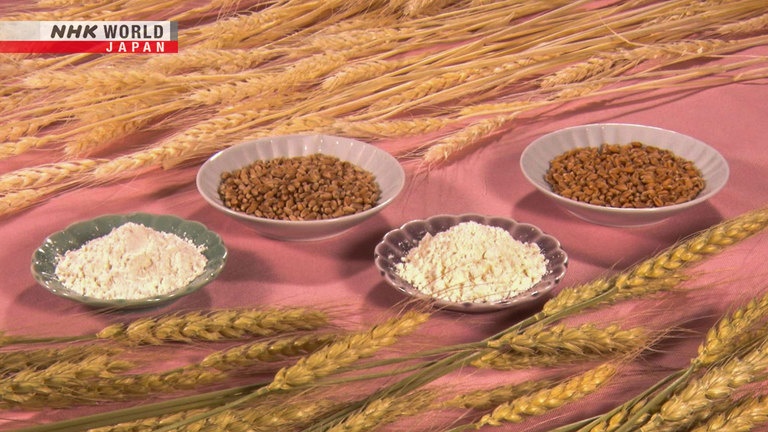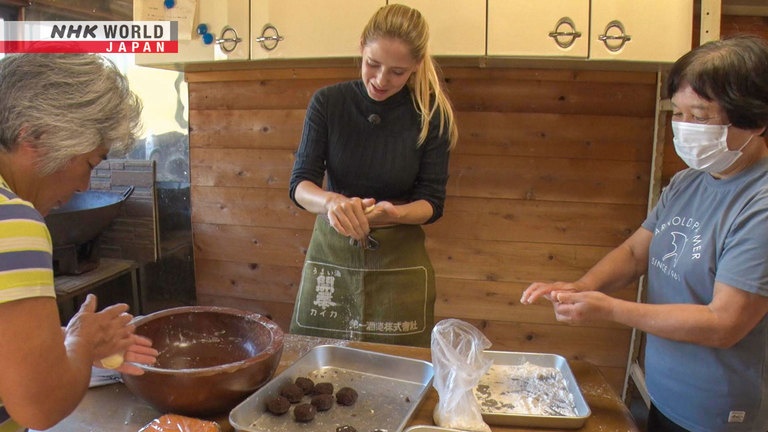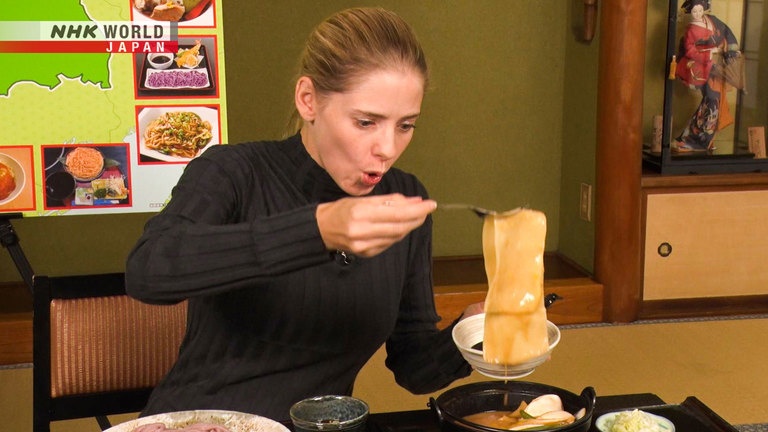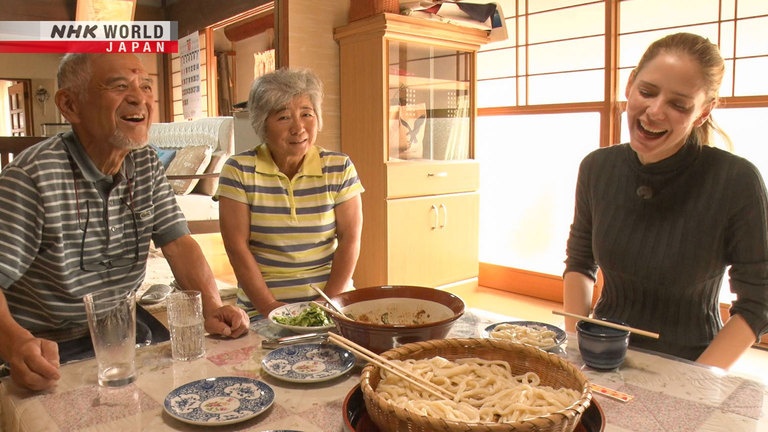SAITAMA WHEAT
Saitama Prefecture, next to Tokyo, is known for its wheat cultivation and as an udon noodle kingdom. We explore Saitama's wheat culture by visiting flour mills and farmers and trying local udon and even beer. (Reporter: Janni Olsson)




Transcript
Tokyo: this world-class metropolis is a veritable gourmet wonderland.
Discover the stories behind the ingredients that make this city so delicious - so "oishii."
Our focus today is wheat, one of the three major grains produced worldwide.
It is essential for baking bread.
And in Japan, it's also used to make ramen.
Wow, wow!
Flour made from wheat is used to wrap fillings and make steamed buns.
From savory to sweet, Japan uses wheat in a variety of dishes.
Saitama, next to Tokyo, is one of Japan's top wheat producers.
Udon noodles, made from wheat flour and served with dashi broth,
have long been a staple of Japanese cuisine.
Join us as we bite into Saitama's ever-evolving wheat!
Looks great!
Trails to Oishii Tokyo.
Hello, my name is Janni Olsson, and I'm heading to an event for wheat.
Now, when I hear the word wheat, all I can think about is - ta-da! - bread.
Now I absolutely love bread, and I think we will find lots of this at the event, so let's go.
Janni, from Sweden, is in Otemachi, a business district in central Tokyo.
A festival celebrating wheat is being held here.
Cheers.
Used in the dishes is new wheat, just harvested this year.
Here, freshly picked and ground wheat can be enjoyed like a fresh nouveau wine.
There are a number of dishes that use this new wheat: from courses to pizza to noodles.
There are 12 stores dedicated to bread alone, and the place is packed with bread fans.
Everything looks so good.
The long line here is for the shop run by Wakamatsu Daisuke, a baker known as a "Wheat Magician."
- Hello.
- Hi.
- Your bread looks great.
- Thank you.
All made with Japanese wheat?
Yes, specifically grown near
Kawagoe, Saitama, where I live!
- Saitama?! That's very close to Tokyo!
There's wheat grown there?
- Yes.
To display the uniqueness of different wheats, Wakamatsu uses a different one for each bread.
This French-style loaf is made from a wheat called hanamanten which has a rich flavor and chewy texture.
Lovely aroma.
It's really really good.
A thin slice of this bread
is a great snack on its own.
But hanamanten is a difficult-to-use wheat.
When he first tried making bread with it, the aroma and flavor were underwhelming.
After three years of research, he succeeded in bringing out its full flavor.
The time-consuming process involves mixing flour, water, and salt,
letting the dough rest for one day, allowing it to ferment and ripen for another day,
and baking it on the third day.
This loaf is made with a wheat called ayahikari.
Totally different flavor.
Hanamanten is rich.
This one is more aromatic.
Kind of refreshing, like a rice cracker.
You want to add something on top.
True. Like ham or cheese.
So different. Interesting!
I want everyone to know that
Saitama makes some great wheat.
- I've got to visit.
- Please!
To learn more, Janni visits Satte, northeastern Saitama.
I think we're here.
This mill specializes in domestic wheat.
CEO Irie Kazuomi shows Janni around.
This is a wheat silo.
It's huge!
There are currently four types of wheat grown in Saitama.
Hanamanten, norin 61, ayahikari, and satonosora.
Norin 61 has been grown for about 80 years.
It's a traditional wheat with a brown color and a strong aroma.
Satonosora, on the other hand, has no distinctive wheat smell.
It's popular for use in sweets.
Wow.
Being milled now is ayahikari.
First, wheat is crushed.
This is what it's like at this step. Cool!
The crushed wheat is first sifted and roughly separated into hulls and flour.
Blowing air from below while vibrating, this machine lifts and removes only the light skins.
By repeating this process, single grains of wheat are sorted into 45 different parts.
So many.
These are just three of the 45 types.
Each type has different qualities, and is blended according to its intended use.
This is a little coarse.
Yes. Good for udon.
This white, fluffy type is just right for sweets.
The brownish part from near the skin is savory, and good for bread blends.
I thought that once wheat was ground,
it became flour.
- I didn't know there were so many different parts,
and that they could be blended. Interesting.
- Right?
Meticulous blending produces just the right flour for the right product.
We want people to know more about wheat,
and promote a culture of enjoying diverse wheat.
Above all, our mission is to tell people
that wheat from Saitama is delicious!
Mills like this one offering wheat with quality and pride
is part of what has built a culture of wheat here in Saitama.
Wheat cultivation is thought to have begun in Japan around the 1st century B.C,
but cultivation in Saitama flourished thanks to a single individual.
Gonda Aizo, a farmer from Saitama.
Gonda worked hard to increase wheat production.
He invented "wheat stomping," a method in which after germination,
roots are stomped on to improve root spread and cold resistance.
He also advocated the cultivation method of "double cropping,"
in which wheat is grown after harvesting rice.
With his methods, he succeeded in increasing the wheat harvest by some 500 percent.
As a result, wheat-based meals became common in Saitama, especially among farmers.
"Buns for breakfast, udon for lunch" was a common refrain.
"Itadakimasu."
Buns and udon weren't just a daily staple.
They were also made to be served at weddings, funerals, and other special occasions.
Some farmers in Saitama still hold these customs dear.
Janni visits one such farming family in Kazo, northeastern Saitama.
- Hello.
- Welcome.
Egawa Yoshio and Kimiyo are fifth-generation farmers.
- I'll show you the udon workshop.
- Workshop?
They take Janni to a corner of their property.
Here.
- An udon-making workshop?
- That's right.
Wow.
We've been using this for generations.
- For generations?
- Yeah.
They use locally harvested ayahikari wheat.
Kazo is a wheat producer. Why not use what we grow?
Pour just half of it.
He mixes salt water with wheat flour.
Then he adds the rest of the water and mixes it further.
- Now we let it sit so that gluten is released.
- For how long?
20 to 30 minutes.
Then we stomp on it.
Excuse me?
Stomp on it. It's tough work.
With bare feet.
How funny.
Stepping on it activates the gluten, making the dough springier.
Has it been done like this for a long time?
Yes, absolutely.
Otherwise the udon tastes no good.
- Really?
- Really.
It's Janni's turn.
- On my heels?
- Slowly. About 40 times.
40 times! Interesting.
Good job.
Stomp, let it rest for 30 minutes, and repeat three times.
With this, the udon becomes springy and firm.
Feel it.
It has a totally different texture.
True. Nice and springy.
Now we make noodles.
The finished dough is stretched with a rolling pin.
Once it's three millimeters thin, he folds it while shifting the edges slightly,
then cuts from the edge inward.
The noodles are boiled for 12 minutes.
Good. They stay on the chopsticks.
If the noodles stick to the chopsticks, it means they've been boiled to the core.
After soaking in cold water, they're ready to eat.
- Let's make buns next.
- Okay!
The ingredients are ayahikari flour, baking powder, sugar, water, and milk.
The dough is kneaded well then rounded into receptacles for azuki bean paste.
Kimiyo's sister helps out when there are many buns to be made.
Do you often do this as family?
Our siblings were all girls.
We all followed mom's lead.
In the hot summer.
We made them for the summer festival.
Once I got married, mom made them and
brought them for my new family.
How sweet.
They also make sekihan, or red bean rice.
The sticky rice is soaked overnight in broth.
Great aroma.
Have you tried sekihan?
No. What is it, anyway?
It's a dish for celebrations.
I've seen it on TV, but never tried it.
Now's your chance.
Nice steam. Oh, pretty.
Red is a celebratory color in Japan, so it's often served on festive occasions.
- Now we put buns on top.
- No way.
We steam the buns with the rice.
- They're normally steamed alone, right?
- Right.
It's steamed for about 10 minutes.
Amazing aroma. So nice.
We cover the buns in the rice.
I've never seen rice buns like this.
After another 10 minutes of steaming, the sekihan-covered buns, or iga-manju, are ready.
This is great. Such a lovely aroma.
These local Kazo dishes have been passed down from generation to generation.
It's time to prepare the udon soup.
Sugar plus homemade miso and sesame are mixed in a mortar.
Then cucumbers, shiso leaves, and myoga from the field are added and stirred with ice cubes.
In summer, the heat naturally melts the ice, creating a chilled dipping sauce.
It's becoming soup-like.
I can smell the sesame. Nice.
They'll pair the chilled soup with this udon.
Wow, it's long.
Yeah. Well made.
Like a metaphor for long, happy lives.
Nice symbolism.
"Itadakimasu."
"Oishii."
- Quite refreshing.
- Perfect for summer.
Nice and firm. Pairs well with sesame.
A dish packed with nutrients to get you through the hot summer months.
Udon made with flour from our area is like this,
but the thickness varies from place to place.
Some noodles are darker, depending on the flour.
Even in Saitama alone, there are various kinds.
Next, one of those "burr buns," packed with paste.
Heavier than I thought.
"Oishii."
The outside is bouncy, but the inside is moist.
We give them to our neighbors.
They give us theirs as well.
- A nice way to build friendships.
- Exactly.
A custom we want to keep.
The blessings of nature and a wish to share joyous times with those close to us -
all packed into the wheat-based udon and buns of Saitama.
There are a lot different types of udon here in Saitama
so today I called a person that knows quite a lot about it.
- Hi, Mr. Nagatani.
- Thanks for having me.
Nagatani Akihisa is the chair of an association aiming to make Saitama the "best udon prefecture in Japan."
He holds lectures and udon-making workshops as a part of that promotional push.
How many types of udon do you
think there are in Saitama?
I heard there are a lot.
Maybe 6 or 7?
Look at this map.
So many!
It's said there are over 20 types.
That's a lot.
This looks like a sausage. Is it actually udon?
Yes, it's called "one-noodle udon."
Just one huge noodle.
Another example is Sayama tea udon, kneaded with tea, a specialty of the city.
Saitama udon comes in a huge number of colors and shapes.
Quite a variety. They look different,
and I bet they all taste different, too.
Here are five types that really stand out.
What is this?
Kawahaba udon.
Made to commemorate Japan's widest river,
which is in this area.
The noodles are about 6cm wide.
Kawahaba udon is a specialty in Konosu, in northeast Saitama.
It was inspired by the width of the Arakawa River as it runs through the area.
The wide noodles pair well with miso soup.
It kind of looks like a blanket.
"Itadakimasu."
Nice and chewy.
Good umami from the shellfish in the soup.
These bright purple noodles are wisteria udon,
named after the wisteria of Ushijima, a nature preserve in Kasukabe, northeastern Saitama.
A sweet potato called ayamurasaki-imo imparts the color and helps the noodles go down smoothly.
Niboto is stewed with 14 different ingredients, like Saitama's famous Fukaya scallions.
Hatogaya sauce-yaki udon is stir-fried with a brown sauce.
This is just a taste of Saitama's many local udon dishes.
Last but not least, there's the essential Musashino udon.
The Musashino area stretches from Tokyo to Saitama.
The very firm Musashino udon has been eaten in this area for centuries.
Quite springy and firm.
- That's right. It's known for
having quite a firm texture.
- Oh?
Not so firm that you have to bite it,
but not that smooth, either.
Firm and chewy.
One person was so drawn to this wheat that he quit his job
to open a Musashino udon restaurant in Tokorozawa, Saitama.
His name is Kaneko Noboru.
He uses Norin 61, the classic variety known for its strong flavor.
Kaneko grows it on his own farm and mills it himself.
Norin 61 is the best for udon.
When made into noodles, it takes on a weighty whiteness.
This brown-flecked color is thanks to Norin 61.
Being able to taste the original flavor of the wheat is one appeal of this type.
Some old-school fans say udon made
with flour other than Norin 61 isn't udon.
- Does Norin 61 have a lot of fans?
- It does.
You have so many types of udon here.
It keeps evolving.
Keep your eyes on the udon of Saitama.
Udon fans love Norin 61.
But its unique wheat aroma attracts more than just udon fans.
Janni visits Ogawa, central Saitama, a town known for its sake breweries and wineries.
I think it's over here.
Here's a brewery of a different kind.
- Hello.
- Welcome.
Suzuki Hitoshi is its second-generation owner.
His brewery's signature drink is a white beer made with wheat.
This is the main ingredient, Norin 61.
By using udon wheat flour,
we try to create a distinctive aroma and flavor.
Wheat, along with ingredients like barley malt, is mixed in a tank of warm water.
Over the course of an hour, the starches are converted to sugar.
What a sweet smell! It really fills the room.
They check the levels of sugar, essential for alcohol production, at each step of the process.
It's 19 degrees Plato.
That means it's sweeter than mangoes.
This is called the first wort.
- What's this?
- The richest and sweetest wort.
Looks rich.
And what a sweet aroma.
- Wow. Very sweet.
- The sweetest.
When yeast is added, it eats the sugar and converts it
into alcohol and CO2. That's what makes beer.
That's why there's very little
of this sweetness left in the beer.
That's wild.
Next, the wort is boiled for sterilization and to remove excess moisture.
These are hops.
They're in pellet form.
Hops are added to give the beer bitterness and aroma.
The final step is the fermentation tank.
Alcohol forms for about two weeks, then the beer matures in refrigeration.
Looks great.
In a month, a beer with a refreshing aroma and sour flavor is ready.
Smells very fresh. Let me try.
Very good. Quite refreshing.
I agree.
The wheat components mellow the flavor.
They also give it a slight sourness,
which makes for a refreshing, easy-to-drink beer.
So that's the role of the wheat.
The sweetness and flavor of the resulting beer
is just to my liking. Nice surprise.
Norin 61 has a strong character.
It's tough to use in beer because of its
distinctive aroma and dark color.
By daring to use it, we want our customers to
enjoy its characteristics through our beer.
For me, wheat was once an everyday item I didn't think much about.
But by visiting Saitama, I saw that the more you learn about wheat,
the more you appreciate what a fascinating ingredient it is.
"Oishii."
I always thought of Japan as a country of rice, but its wheat culture is just as rich.
Here, wheat isn't just an ingredient: it helps connect people!
Saitama wheat is worth looking out for in the future.
In Saitama, every ingredient has its own story.